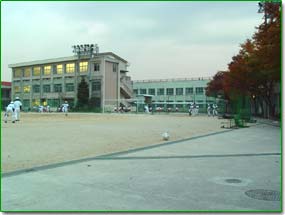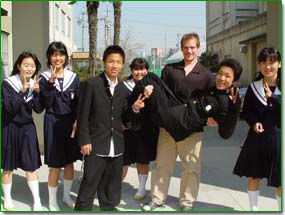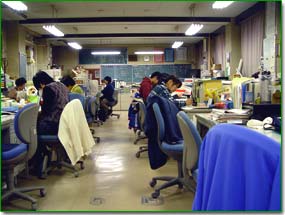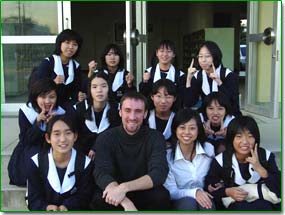 Now for the justification of your all-expenses paid flight to Japan and your three night stay in a posh Tokyo hotel (the orientation),
let's talk about the job. As was mentioned earlier, our lives are quite a bit different from our rice paddy brethren and that includes
the job. Don't worry. It's usually a good thing.
Now for the justification of your all-expenses paid flight to Japan and your three night stay in a posh Tokyo hotel (the orientation),
let's talk about the job. As was mentioned earlier, our lives are quite a bit different from our rice paddy brethren and that includes
the job. Don't worry. It's usually a good thing.
In the materials you've received and in information you have yet to be exposed to, you will hear all kinds of job descriptions from "base schools" to "semi-regular visits" to "one shots" etc., etc... Well, in Nagoya you'll likely have just one school to call your own for the year, with the occasional chance of being "loaned out" to another school. As was mentioned earlier, in Nagoya there are some 14 senior high schools, 110 junior high schools and somewhere around 365 elementary schools. Including the privately contracted non-JET AETs, there are currently some 90 total AETs in the city. As far as Nagoya is concerned, English education begins in Junior High School, and is required through graduation from Senior High School. Some of the non-JET AETs have two schools, but generally the JETs only have one school for the year, either a large junior high school (over 700 students), or a senior high school. Since you'll be at one school for the year, you have a great opportunity to become friends with a lot of your co-workers, and of course, the kids themselves. Because the city has decided to make a big push for elementary English exposure, don't be surprised if you're asked to visit a nearby elementary school on some of your school's test days. Don't worry at all though: essentially all this means is that you get to be a superstar for a couple of hours to some little kids. So that's basically the logistics of what your new job is going to be.
 As for the job itself, you'll find one thing that is universal in the JET Program — the "A" in AET stands for assistant, thus you
do not have a class of your very own. It's done in some semblance of coordination with your partner-in-crime the JTE (Japanese Teacher of
English). Ideally, you will plan lessons together, but that can sometimes be far from the case. Some JTEs are militant with their English
classes and teach from the government-standardized textbook, "New Horizons". Other JTEs basically ask that you run the show when you're
teaching a class (sometimes even leaving the room!). But generally, your working relationship with the JTEs will be somewhere in between.
Each school has from two to six JTEs or so, (each JTE generally teaches only one grade level) and class sizes are usually in the
neighborhood of 36. Students vary in numbers from 200 for the smallest of schools (maybe 2 classes per grade) to a bit over 1000 for the
monster ones (10-11 classes per grade).
As for the job itself, you'll find one thing that is universal in the JET Program — the "A" in AET stands for assistant, thus you
do not have a class of your very own. It's done in some semblance of coordination with your partner-in-crime the JTE (Japanese Teacher of
English). Ideally, you will plan lessons together, but that can sometimes be far from the case. Some JTEs are militant with their English
classes and teach from the government-standardized textbook, "New Horizons". Other JTEs basically ask that you run the show when you're
teaching a class (sometimes even leaving the room!). But generally, your working relationship with the JTEs will be somewhere in between.
Each school has from two to six JTEs or so, (each JTE generally teaches only one grade level) and class sizes are usually in the
neighborhood of 36. Students vary in numbers from 200 for the smallest of schools (maybe 2 classes per grade) to a bit over 1000 for the
monster ones (10-11 classes per grade).
 The schools themselves are organized a bit differently from those we know in our home countries. The students, as opposed to the teachers,
have their own classrooms. Teachers have a desk in the teachers' room in which all school employees, besides the principal are based.
The principal usually gets a monster, plush office that doubles as a conferance room and is usually the first place you'll go when you
arrive on the scene your first day. You will go to the students' classrooms class. In your off periods, you will probably be in the teachers'
room planning lessons, making games and activities, talking with teachers, reading a good book, writing letters, (programming websites...)
whatever it is that keeps you busy. If sitting around isn't your cup of tea, many times you can join a P.E. class, go cook food in Home Ec
with the kids, or even sit in on a science or math class or whatever if you ask the teacher first. We work Monday to Friday, 8:15 - 4:15
(or so, somewhat depends on your school), and teach on average 3-4 classes per day.
The schools themselves are organized a bit differently from those we know in our home countries. The students, as opposed to the teachers,
have their own classrooms. Teachers have a desk in the teachers' room in which all school employees, besides the principal are based.
The principal usually gets a monster, plush office that doubles as a conferance room and is usually the first place you'll go when you
arrive on the scene your first day. You will go to the students' classrooms class. In your off periods, you will probably be in the teachers'
room planning lessons, making games and activities, talking with teachers, reading a good book, writing letters, (programming websites...)
whatever it is that keeps you busy. If sitting around isn't your cup of tea, many times you can join a P.E. class, go cook food in Home Ec
with the kids, or even sit in on a science or math class or whatever if you ask the teacher first. We work Monday to Friday, 8:15 - 4:15
(or so, somewhat depends on your school), and teach on average 3-4 classes per day.
Most of our working hours are spent in school, but there is one other island of official workdom in which we can be found from time to time: the Kyouikukan. As mentioned earlier, this is the location of our base office downtown where three of our five supervisors can be found on most occasions. It's not a beautiful place — kind of a mid-twentieth century grouping of concrete slabs — but the location couldn't be more convenient. It's right in the beating heart of the city, with all the main shops, restaurants and bars just a few steps away. Once every two weeks we have a meeting at this office with our supervisors where we discuss official job-related business, teaching/lesson planning seminars, and other unofficial business. Paddy O'Brien, (the office leader), Liberty Wilson, (counselor #1) and James Rogers (couselor #2) will keep you well-informed about everything. You name it. We talk about it.
 Basically any working day you're not at your school, you'll be at the Kyouikukan. This means primarily holiday periods. Our main ones are
winter (late December - early January), spring (mid March - mid April). And summer (mid July - beginning of September). There will be
the odd day here and there where we'll find ourselves in the office as well. The time spent there is usually quite informal and most often
we aren't required to put in a complete working day.
Basically any working day you're not at your school, you'll be at the Kyouikukan. This means primarily holiday periods. Our main ones are
winter (late December - early January), spring (mid March - mid April). And summer (mid July - beginning of September). There will be
the odd day here and there where we'll find ourselves in the office as well. The time spent there is usually quite informal and most often
we aren't required to put in a complete working day.
But hey! What about time off from this insanity!? O.K. O.K. here it is. Yes, we have yearly vacation allotted to us. Officially it is called "nenkyuu" and it is technically considered paid sick days. In practice it is most often used as vacation during the before mentioned holiday periods. We have 24 days a year at our disposal (including sick days). These are the only paid off-days we have besides national public holidays (which seem to happen every couple weeks or so — Japanese people love holidays), but don't worry, for most people it hits just about right. Even if it doesn't it is perfectly acceptable to take more days. The only catch is that your next paycheck may seem a bit on the shallow side.